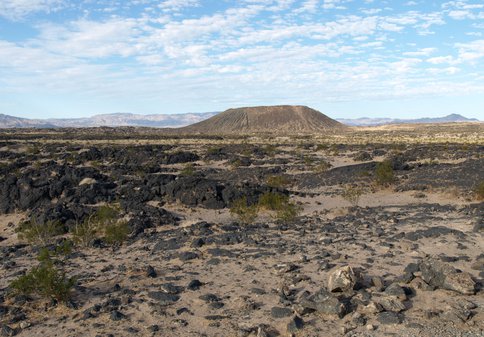2009 Annual Science Report
 VPL at University of Washington
Reporting | JUL 2008 – AUG 2009
VPL at University of Washington
Reporting | JUL 2008 – AUG 2009
Limits of Habitability
Project Summary
The study of planetary habitability necessitates an interdisciplinary approach. The factors that can affect the habitability of planetary environments are numerous, and the disciplines that can contribute to their investigation and interpretation include, physics, chemistry, geology, biology, and astronomy to name a few.
Project Progress
Limits of Habitability on Earth
We visited field sites in both the Mojave Desert (USA) and Svalbard, the arctic (leveraged off co-investigator Conrad’s participation as a co-investigator to the NASA ASTEP AMASE field campaign.) At these field sites, we measured several environmental parameters that we hypothesize to affect the habitability of those sites. We also conducted a biological survey to determine the abundance and diversity of life in the defined areas in order to correlate the presence of life with the measured environmental features. These habitability factors included temperature, humidity, inventory of chemical elements, mineralogical diversity, inventory of trace gases other than nominal atmospheric gases, mechanical stability, wind speed and direction, magnetic and electrostatic field strength and direction, intensity of wavelength-specific solar radiation and several other parameters. The biological measurements included a vegetation survey, and molecular analysis including PCR (16s) for determining diversity, LAL and ATP for determining organism viability, and a survey of biological pigments (Conrad et al., 2009).
At these two sites we also collected reflectance spectra at wavelengths from 380 nm to 2500 nm in order to determine if we can observe some of the spectral features associated with habitability at the local spatial scale (about 1 m) scaled to orbital or sub-orbital reflectance data in the same wavelength bands.
Reexamining the Limits of the Circumstellar Habitable Zone.
We also have a nascent project that is reexamining the surface habitable zone. The “classic” habitable zone is defined by the limits of greenhouse gas absorption at the outer edge, and by runaway greenhouses on the inner edge. We are currently running coupled photochemistry/climate models that include the shielding effects of organic hazes similar to that on Titan and the early Earth. This will test the degree to which the inner edge of the habitable zone can be pushed closer to the parent star as the shielding decreases the energy input to the surface and prevents runaway greenhouses from forming. At the outer edge of the habitable zone, we are including absorption of incoming solar radiation in the lower atmosphere. Because the temperature in the lower atmosphere is coupled to the surface temperature, this has a similar effect to decreasing the albedo of the surface, thereby increasing the surface temperatures. Our goal is to see how far we can extend the outer edge of the habitable zone further outward due to these effects.
The Outer Limits of Habitability: Enceladus’ Conditions for Life
The prolific activity and presence of a plume on Saturn’s tiny moon Enceladus offers us a unique opportunity to sample the interior composition of an icy satellite, and to look for interesting chemistry and possible signs of life. Based on studies of the potential habitability of Jupiter’s moon Europa, icy satellite oceans can be habitable if they are chemically mixed with the overlying ice shell on Myr time scales. We hypothesize that Enceladus’ plume, tectonic processes, and possible liquid water ocean may create a complete and sustainable biogeochemical cycle that may allow it to support life. We discuss evidence for surface/ocean material exchange on Enceladus based on the amounts of silicate dust material present in the Enceladus’ plume particles. Microphysical cloud modeling of Enceladus’ plume shows that the plume particles originate from a region of Enceladus’ surface where the temperature exceeds 190 K. This could be consistent a shear-heating origin of Enceladus’ tiger stripes, which would indicate extremely high temperatures (˜273 K) in the subsurface, leading to the generation of subsurface liquid water, chemical equilibration between surface and subsurface ices, and crustal recycling on a time scale of 1 to 5 Myr. Alternatively, if the tiger stripes form in a mid-ocean- ridge-type mechanism, a half-spreading rate of 1 m/yr is consistent with the observed regional heat flux of 250 mW m-2 and recycling of south polar terrain crust on a 1 to 5 Myr time scale as well (Parkinson et al., 2009).
Amboy Lava Field is actually quite habitable and home to several grasses and woody plants, reptiles, mammals, as well as robust microbial populations in both the soils and on the weathered basalt.
Publications
-
Li, K-F., Pahlevan, K., Kirschvink, J. L., & Yung, Y. L. (2009). Atmospheric pressure as a natural climate regulator for a terrestrial planet with a biosphere. Proceedings of the National Academy of Sciences, 106(24), 9576–9579. doi:10.1073/pnas.0809436106
-
Parkinson, C. D., Liang, M-C., Yung, Y. L., & Kirschivnk, J. L. (2008). Habitability of Enceladus: Planetary Conditions for Life. Orig Life Evol Biosph, 38(4), 355–369. doi:10.1007/s11084-008-9135-4
- Conrad, P.G., M.L.Fogel, Glamoclija, M., Kerr, L., Mogensen, C., Eigenbrode, J., Mahaffy, P.R. & Steele, A. (2009). Metrics for Habitability Assessment. 40th Lunar Plan. Sci.
- Parkinson, C.D., Liang, M-C. & Yung, Y.L. (2008). Habitability of Enceladus: Planetary Conditions for Life. EGU General Assembly.
-
PROJECT INVESTIGATORS:
-
RELATED OBJECTIVES:
Objective 1.1
Formation and evolution of habitable planets.
Objective 1.2
Indirect and direct astronomical observations of extrasolar habitable planets.
Objective 2.1
Mars exploration.
Objective 4.3
Effects of extraterrestrial events upon the biosphere
Objective 6.2
Adaptation and evolution of life beyond Earth






